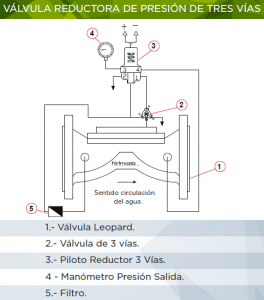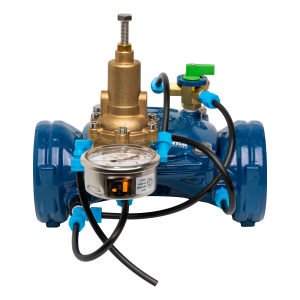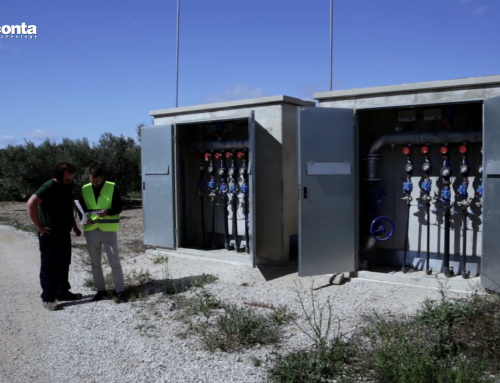The control valves adapt the network pressure and the flow.
The function of a control valve is to adjust the pressure that is downstream of the hydraulic valve in relation to the hydraulic pressure upstream pressure.
There are many configuration possibilities behind the hydraulic control valves in order to meet all the requirements regarding pressure or flow.
For instance, the pressure reducer hydraulic valve is able to reduce pressure up to ⅓ of the inlet pressure. therefore, for a 6 bar inlet pressure it could get 2 bar outlet pressure.
The pressure reducer hydraulic valves are used to protect hydraulic installation and adjust the pressure supply.
 válvulas reguladoras adaptan la presión y el caudal de una conducción presurizada a la requerida por ésta. El funcionamiento de la válvula reguladora consiste en, a través de la propia conducción del fluido, regular la presión que lleva el agua a la entrada en la válvula hidráulica con respecto a la de salida de la válvula reguladora. Existen diferentes posibilidades de configuración en las válvulas hidráulicas para ajustarse a todas las necesidades de presión, caudales, etc. Por ejemplo, la válvula reductora de presión puede reducir la presión hasta a un 1/3 de la presión de entrada. Por lo tanto, para una presión de entrada de 6 bar, la presión de salida sería de 2 bar. En caso de que la presión aguas arriba sea menor que la tarada, el piloto dejará la válvula hidráulica abierta y actuará únicamente cuando la presión aguas abajo supere la presión establecida. Este tipo de válvulas reductoras de presión se utilizan principalmente para proteger instalaciones hidráulicas y ajustar la presión de suministro. Ya sabes que es una válvula reguladora de presión de agua, pero ¿cómo funciona una válvula hidráulica reductora de presión? Para entender su funcionamiento primero debemos saber de qué se componen. Las válvulas reguladoras de presión más básicas incluyen en su ensamblaje, un piloto reductor, una válvula de 3 vías, un filtro para evitar posibles obstrucciones y un manómetro donde se refleja la presión de salida del agua. El piloto hidráulico es el elemento que actuará para ajustar la presión de salida que tendrá el agua. Por lo tanto, el piloto fija la presión aguas abajo independientemente de la presión de entrada. En caso de que la presión aguas arriba sea menor que la tarada, el piloto dejará la válvula hidráulica abierta y actuará únicamente cuando la presión aguas abajo supere la presión establecida.” width=”264″ height=”300″ />
válvulas reguladoras adaptan la presión y el caudal de una conducción presurizada a la requerida por ésta. El funcionamiento de la válvula reguladora consiste en, a través de la propia conducción del fluido, regular la presión que lleva el agua a la entrada en la válvula hidráulica con respecto a la de salida de la válvula reguladora. Existen diferentes posibilidades de configuración en las válvulas hidráulicas para ajustarse a todas las necesidades de presión, caudales, etc. Por ejemplo, la válvula reductora de presión puede reducir la presión hasta a un 1/3 de la presión de entrada. Por lo tanto, para una presión de entrada de 6 bar, la presión de salida sería de 2 bar. En caso de que la presión aguas arriba sea menor que la tarada, el piloto dejará la válvula hidráulica abierta y actuará únicamente cuando la presión aguas abajo supere la presión establecida. Este tipo de válvulas reductoras de presión se utilizan principalmente para proteger instalaciones hidráulicas y ajustar la presión de suministro. Ya sabes que es una válvula reguladora de presión de agua, pero ¿cómo funciona una válvula hidráulica reductora de presión? Para entender su funcionamiento primero debemos saber de qué se componen. Las válvulas reguladoras de presión más básicas incluyen en su ensamblaje, un piloto reductor, una válvula de 3 vías, un filtro para evitar posibles obstrucciones y un manómetro donde se refleja la presión de salida del agua. El piloto hidráulico es el elemento que actuará para ajustar la presión de salida que tendrá el agua. Por lo tanto, el piloto fija la presión aguas abajo independientemente de la presión de entrada. En caso de que la presión aguas arriba sea menor que la tarada, el piloto dejará la válvula hidráulica abierta y actuará únicamente cuando la presión aguas abajo supere la presión establecida.” width=”264″ height=”300″ />
You already know how a control valve works but let us explain you how a pressure reducer hydraulic valve works.
First of all to understand its functioning you must know all the assets that a pressure reducer valve has. These valves are made up of a reducer pilot, a 3 way valve, a filter and a manometer that shows the outlet pressure.
The hydraulic pilot will act to adjust the outlet pressure. Therefore, the pilot sets downstream pressure regardless of inlet pressure. In the event that the upstream pressure is less than the set value, the pilot will leave the hydraulic valve open and will act only when the downstream pressure exceeds the set pressure.




